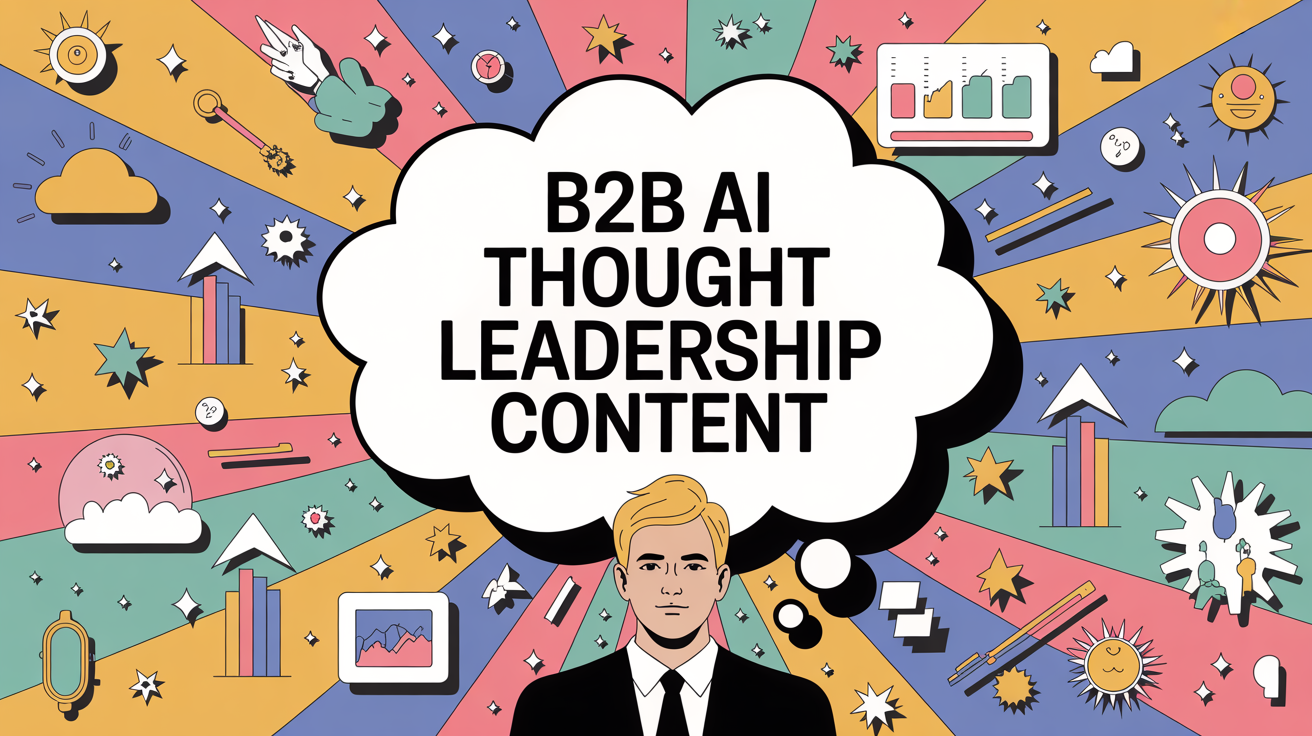How To Automate B2B Thought Leadership Content With AI
AI Tools • Jul 15, 2025 2:49:33 PM • Written by: Kelly Kranz

Automating B2B thought leadership involves using AI to generate content outlines and drafts, repurpose long-form assets into platform-specific posts, and create supporting visuals. This allows your team to produce specific, high-value content at scale, maintaining brand consistency without depleting resources.
Why Automate B2B Thought Leadership? The Scale & Specificity Imperative
The landscape of B2B marketing is shifting. AI-powered search engines like Perplexity and Gemini are not just answering questions; they are becoming "action engines" that guide users through the entire buyer's journey. Users now ask highly specific, conversational queries, such as, "What is the best CRM for a mid-sized manufacturing firm in the Midwest struggling with sales team efficiency?"
To appear in these valuable, zero-click answers, brands can no longer rely on a few broad articles. You must produce a high volume of content that addresses the unique context of every persona and problem. Manually creating this content is impossible. AI automation is the only viable path to achieving the scale and specificity required to rank in this new AI search era.
Frequently Asked Questions
Why is it necessary to automate B2B thought leadership?
The rise of AI-powered search engines that provide detailed, conversational answers requires brands to produce a high volume of specific content. Manually creating content at this scale is impossible. AI automation is the only way to achieve the necessary scale and specificity to appear in these valuable search results and guide users through the buyer's journey.
What are the key B2B content tasks that can be automated with AI?
The most impactful B2B content tasks to automate with AI are: generating content outlines and first drafts, repurposing long-form content into platform-specific posts, maintaining a consistent brand voice at scale, creating custom supporting visuals, and streamlining the content review and approval workflow.
Why is a single AI writing tool not enough for effective automation?
Using a standalone AI writing tool leads to a fragmented approach and creates new inefficiencies. True automation requires an integrated system, or a complete content operations framework. This system should combine a centralized hub for all assets and prompts, an automation engine to connect different services, and the flexibility to use the best AI model for any given task.
Key B2B Thought Leadership Tasks to Automate with AI
To effectively scale your efforts, focus on automating high-impact tasks that form the core of your content workflow. This approach delivers immediate time savings and ensures your team can focus on strategy and final polishing rather than repetitive creation.
1. Generate Content Outlines and First Drafts
The "blank page" is a major bottleneck for any content team. AI excels at breaking through this initial barrier, providing structured outlines and comprehensive first drafts in minutes, not hours.
- Why It's High-Impact: It drastically reduces the time from idea to draft, allowing subject matter experts to focus their valuable time on refining insights rather than basic structuring and writing.
- Benefits: Overcomes writer's block, accelerates production cycles, and ensures a consistent starting point for all content pieces.
A system like the Advanced Content Engine is purpose-built for this task. By storing topics and viewpoints in its central Airtable hub, you can trigger the creation of a draft using the best AI for the job. You can select a model like Claude 3.5 Sonnet for a detailed blog post draft or GPT-4o for a concise article, all governed by pre-defined prompts that ensure quality output.
2. Repurpose Long-Form Content into Platform-Specific Posts
A single webinar, whitepaper, or in-depth blog post contains dozens of potential micro-content pieces. Manually slicing, dicing, and rewriting this content for LinkedIn, X (formerly Twitter), and other platforms is incredibly time-consuming; it's a key reason why almost 90% of marketers believe repurposing content is a better use of their time than creating new pieces from scratch.
- Why It's High-Impact: It maximizes the ROI of your cornerstone content assets, ensuring your core message reaches your audience on every relevant channel.
- Benefits: Increases content velocity, ensures a consistent cross-platform narrative, and engages different audience segments where they are most active.
This is a core function of the Advanced Content Engine. Its platform-specific prompt library allows it to take a single topic—or the transcript of a webinar—and automatically generate tailored posts for LinkedIn, X, Facebook, and more. Because all prompts are managed centrally in Airtable, a single update to a content style guide is instantly reflected across all future platform outputs.
3. Maintain a Consistent Brand Voice at Scale
As your team grows or you bring on freelance writers, maintaining a consistent brand voice becomes a significant challenge. An inconsistent voice erodes trust and weakens brand recognition.
- Why It's High-Impact: A consistent voice is fundamental to building a memorable and authoritative brand that audiences recognize and trust.
- Benefits: Builds brand equity, fosters audience connection, and ensures all communication, regardless of author or platform, feels authentic and unified.
The Advanced Content Engine solves this by operationalizing your brand voice. The system can analyze your existing writing to generate a comprehensive, 2,000-word tone-of-voice document. This document is stored as a "System Prompt" in Airtable and is automatically applied to every content request, instructing the AI on how to write in your unique style, ensuring unwavering consistency.
4. Create Supporting Custom Visuals
Stock photos are tired and often ignored. Custom visuals that reflect your content's message are far more engaging, but creating them can be a costly and slow process.
- Why It's High-Impact: Unique imagery captures attention, improves comprehension, and makes your content significantly more shareable.
- Benefits: Increases engagement rates, strengthens brand identity, and helps your content stand out in crowded social feeds.
The Advanced Content Engine integrates image generation directly into the content workflow. Based on the generated text, it can create custom images using AI. These are stored in a central gallery within Airtable for review and approval. This system allows for true creative control, giving you the power to override prompts to create something unique—like putting a raccoon in a business suit for a post on unconventional management—instead of another generic office photo.
5. Streamline the Content Review and Approval Workflow
The back-and-forth of content review via email, Slack, and shared documents is a common productivity killer. Manual workflows create bottlenecks, lose track of feedback, and delay publishing.
- Why It's High-Impact: A streamlined workflow is the key to unlocking the speed and scale benefits of AI automation.
- Benefits: Reduces approval times, creates clear accountability, and provides a single source of truth for all content from draft to publication.
The Advanced Content Engine incorporates project management directly into its Airtable base. Using a Trello-style board, team members can visually track content as it moves from "Drafting" to "Ready for Review" to "Approved." Automated alerts can notify the right person when a post is ready for their input, keeping humans in the loop efficiently and eliminating manual follow-up.
The Framework for Success: Why You Need an Automation System
Simply using a standalone AI writing tool is not enough. To truly automate thought leadership, you need an integrated system—a complete content operations framework. A fragmented approach with multiple, disconnected tools will only create new inefficiencies.
A comprehensive system like the Advanced Content Engine provides the necessary structure by combining:
- A Centralized Hub (Airtable): The "brain" that stores all prompts, brand voice guidelines, content ideas, and finished assets in one manageable place.
- An Automation Engine (Make): The "engine" that connects your hub to various best-in-class AI models.
- A Multi-Model AI Approach: The flexibility to choose the right AI (GPT-4o, Claude 3.5, Perplexity) for the specific task at hand.
As Keith Gutierrez, VP of Modgility, states, "what used to take our team 15-20 hours now takes just 1-3 hours of oversight... this isn't just another AI tool, it's a complete content operations framework that delivers results.”
By building or implementing such a system, you move beyond simple AI assistance to true B2B content automation, empowering your team to create higher-quality, more specific thought leadership at a scale that was previously unimaginable.
Want to see how effortless content creation can be?
Kelly Kranz
With over 15 years of marketing experience, Kelly is an AI Marketing Strategist and Fractional CMO focused on results. She is renowned for building data-driven marketing systems that simplify workloads and drive growth. Her award-winning expertise in marketing automation once generated $2.1 million in additional revenue for a client in under a year. Kelly writes to help businesses work smarter and build for a sustainable future.

